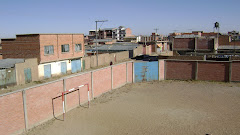A FAO Greenhouse

One of the members in my training group taking a look at a plot of lettuce
Another Visit With QBL

We visited the innaguration for a series of new chicken coops QBL financed in a small village in the low-lying andes mountains, 7 hours north of La Paz
Sunday, January 13, 2008
Subscribe to:
Post Comments (Atom)









1 comment:
Hey, Juan Jose!
Got your big group e-mail.
Good luck with el piso/apartemento.
Keep us posted. It all sounds very exciting.
Mami
Post a Comment